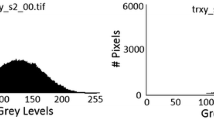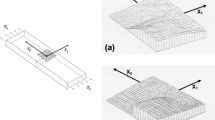Abstract
Background
The DIC Challenge 2.0 follows on from the work accomplished in the first Digital Image Correlation (DIC) Challenge Reu et al. (Experimental Mechanics 58(7):1067, 1). The second challenge was required to better quantify the spatial resolution of 2D-DIC codes.
Objective
The goal of this paper is to outline the methods and images for the 2D-DIC community to use to evaluate the performance of their codes and improve the implementation of 2D-DIC.
Methods
This paper covers the creation of the new challenge images and the analysis and discussion of the results. It proposes a method of unambiguously defining spatial resolution for 2D-DIC and explores the tradeoff between displacement and strain noise (or measurement noise) and spatial resolution for a wide variety of DIC codes by a combination of the images presented here and a performance factor called Metrological Efficiency Indicator (MEI).
Results
The performance of the 2D codes generally followed the expected theoretical performance, particularly in the measurement of the displacement. The comparison did however show that even with fairly uniform displacement performance, the calculation of the strain spatial resolution varied widely.
Conclusions
This work provides a useful framework for understanding the tradeoff and analyzing the performance of the DIC software using the provided images. It details some of the unique errors associated with the analysis of these images, such as the Pattern Induced Bias (PIB) and imprecision introduced through the strain calculation method. Future authors claiming improvements in 2D accuracy are encouraged to use these images for an unambiguous comparison.













Similar content being viewed by others
Notes
Period \(\lambda\) exactly linearly evolves from 10.07 pixels (left-hand side) to 149.93 pixels (right-hand side). It satisfies the formula \(\lambda =10+\frac{150-10}{2000}x\), with \(x\in [1,2000]\).
References
Reu, P.L., Toussaint, E., Jones, E. et al. DIC Challenge: Developing Images and Guidelines for Evaluating Accuracy and Resolution of 2D Analyses. Exp Mech 58, 1067–1099 (2018). https://doi.org/10.1007/s11340-017-0349-0
Savitzky A, Golay MJE (1964) Anal Chem 36(8):1627. https://doi.org/10.1021/ac60214a047. http://dx.doi.org/10.1021/ac60214a047
Jones E, Iadicola M (eds) (2018) A Good Practices Guide for Digital Image Correlation (International Digital Image Correlation Society). https://doi.org/10.32720/idics/gpg.ed1/print.format
Grédiac M, Sur F (2014) Strain 50(1):1
Grédiac M, Blaysat B, Sur F (2017) Exp Mech 57(6):871. https://doi.org/10.1007/s11340-017-0279-x. http://dx.doi.org/10.1007/s11340-017-0279-x
Blaysat B, Neggers J, Grédiac M, Sur F (2020) Exp Mech 60(3):393. https://doi.org/10.1007/s11340-019-00566-4. https://link.springer.com/article/10.1007/s11340-019-00566-4
Wang Y, Lava P, Reu P, Debruyne D (2016) Strain 52(2):110. https://doi.org/10.1111/str.12173. http://dx.doi.org/10.1111/str.12173
Barranger Y, Doumalin P, Dupré JC, Germaneau A (2012) Strain 48(5):357. https://doi.org/10.1111/j.1475-1305.2011.00831.x. https://onlinelibrary.wiley.com/doi/abs/10.1111/j.1475-1305.2011.00831.x
Orteu JJ, Garcia D, Robert L, Bugarin F (2006) In: Proceedings SPIE, vol. 6341. pp 1–6. http://dx.doi.org/10.1117/12.695280
Rossi M, Lava P, Pierron F, Debruyne D, Sasso M (2015) Strain 51(3):206. https://doi.org/10.1111/str.12134. https://onlinelibrary.wiley.com/doi/abs/10.1111/str.12134
Balcaen R, Wittevrongel L, Reu PL, Lava P, Debruyne D (2017) Exp Mech 57(5):703. https://doi.org/10.1007/s11340-017-0259-1
Reu PL (2011) Exp Mech 51(4):443. https://doi.org/10.1007/s11340-010-9417-4
Blaysat B, Grédiac M, Sur F (2016) Int J Numer Methods Eng 108(3):213. https://doi.org/10.1002/nme.5212. http://dx.doi.org/10.1002/nme.5212
Sur F, Blaysat B, Grédiac M (2018) J Math Imaging Vision 60(5):634. https://doi.org/10.1007/s10851-017-0779-4
Blaber J, Adair B, Antoniou A (2015) Exp Mech 55(6):1105. https://doi.org/10.1007/s11340-015-0009-1. http://dx.doi.org/10.1007/s11340-015-0009-1
Yang J, Bhattacharya K (2019) Exp Mech 59(2):187. https://doi.org/10.1007/s11340-018-00457-0
Landauer A, Patel M, Henann D, Franck C (2018) Exp Mech 58(815-830). https://doi.org/10.1007/s11340-018-0377-4
Olufsen SN, Andersen ME, Fagerholt E (2020) SoftwareX 11:100391. https://doi.org/10.1016/j.softx.2019.100391. https://www.sciencedirect.com/science/article/pii/S2352711019301967
Sur, F., Blaysat, B. & Grédiac, M. On Biases in Displacement Estimation for Image Registration, with a Focus on Photomechanics. J Math Imaging Vis 63, 777–806 (2021). https://doi.org/10.1007/s10851-021-01032-4
Fayad SS, Seidl DT, Reu PL (2020) Exp Mech 60(2):249. https://doi.org/10.1007/s11340-019-00553-9
Pan B, Wang B, Lubineau G, Moussawi A (2015) Exp Mech 55(5):887. https://doi.org/10.1007/s11340-015-9989-0. http://dx.doi.org/10.1007/s11340-015-9989-0
Wittevrongel L, Lava P, Lomov SV, Debruyne D (2015) Exp Mech 55(2):361. https://doi.org/10.1007/s11340-014-9946-3. http://dx.doi.org/10.1007/s11340-014-9946-3
Hild F, Roux S (2012) Exp Mech 52:1503. https://doi.org/10.1007/s11340-012-9603-7. http://dx.doi.org/10.1007/s11340-012-9603-7
Grédiac M, Blaysat B, Sur F (2019) Exp Mech 59(2):219. https://doi.org/10.1007/s11340-018-00461-4
Schreier HW, Sutton MA (2002) Exp Mech 42(3):303. https://doi.org/10.1007/BF02410987. http://dx.doi.org/10.1007/BF02410987
Baldi A, Bertolino F (2015) Strain 248–263. https://doi.org/10.1111/str.12137. http://dx.doi.org/10.1111/str.12137
Pan B, Xie H, Wang Z (2010) Appl Opt 49(28):5501. https://doi.org/10.1364/AO.49.005501. http://ao.osa.org/abstract.cfm?URI=ao-49-28-5501
Acknowledgements
The 2D-DIC Challenge is dedicated to Dr. Laurent Robert. An active and important board member in the early years of the project, who passed away in 2016. He has been sorely missed in the experimental mechanics community. Sandia National Laboratories is a multimission laboratory managed and operated by National Technology and Engineering Solutions of Sandia, LLC., a wholly owned subsidiary of Honeywell International, Inc., for the U.S. Department of Energy’s National Nuclear Security Administration under contract DE-NA-0003525.
Funding
B. Blaysat is grateful to the French National Research Agency (ANR) and to the French government research program “Investissements d’Avenir” for their financial support (ICAReS project, N ANR-18-CE08-0028-01 & IDEX-ISITE initiative 16-IDEX-0001, CAP 20-25). S. N. Olufsen gratefully appreciate the financial support from the Research Council of Norway through the Centre for Advanced Structural Analysis, Project No. 237885 (SFI-CASA). B. Blaysat acknowledges useful discussions with M. Grédiac.
Author information
Authors and Affiliations
Corresponding author
Ethics declarations
Conflicts of Interest
Certain commercial equipment, instruments, or materials are identified in this paper in order to specify the experimental procedure adequately. Such identification is not intended to imply recommendation or endorsement by NIST, nor is it intended to imply that the materials or equipment identified are necessarily the best available for the purpose.
Additional information
Publisher’s Note
Springer Nature remains neutral with regard to jurisdictional claims in published maps and institutional affiliations.
Appendix
Appendix
Comparison with Theory
For most implementations of DIC, the optimal displacement minimizes the SSD criterion on each subset. The corresponding optimal parameters \(q^*\) satisfies:
where \(I_{ref}\) (resp. \(I_{cur}\)) is the reference (resp. current) image and v(x, q) is a polynomial basis function that is either 1st order (affine) or 2nd order (quadratic). Let \(u_{GT}\) be the ground truth displacement. Considering an infinite resolution texture that tracks the underlying material, \(I_{ref}\left( x\right) =I_{cur}\left( x+u_{GT}\left( x\right) \right)\). Equation (4) can be rewritten as
For most implementations of DIC, assuming that the image pattern corresponds to the perfect information carrier, it drives the DIC algorithm to the best solution. The expected DIC solution simply results to the projection of the ground truth displacement to the DIC kinematics, thus neglecting the effect of \(I_{cur}\) in equation (5). This leads to
This result was introduced in [26], experimentally validated in [13, 27] and thoroughly mathematically demonstrated in [20]. It simply corresponds to the effect of the well-known Savitzky-Golay filter. Even though these results are shown only for the SSD, most unweighted criteria lead to the same solution at convergence [28].
These equations produced the expected DIC results for the DIC Challenge 2.0 Star image in Figs. 3, 6 and 8 and produced the curves in the Fig. 14 for affine (1st order) and quadratic (2nd order) shape functions.
Rights and permissions
About this article
Cite this article
Reu, P.L., Blaysat, B., Andó, E. et al. DIC Challenge 2.0: Developing Images and Guidelines for Evaluating Accuracy and Resolution of 2D Analyses. Exp Mech 62, 639–654 (2022). https://doi.org/10.1007/s11340-021-00806-6
Received:
Accepted:
Published:
Issue Date:
DOI: https://doi.org/10.1007/s11340-021-00806-6





